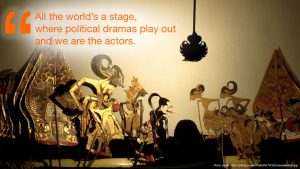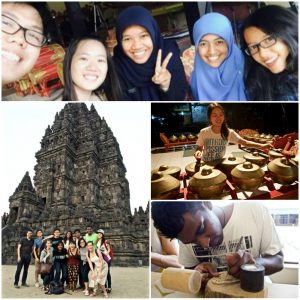Learning about Theatre in the Classroom and Beyond
By Mary Wong Yong Li (Political Science + USP, Class of 2017)
Mary is a student writer for USP Highlights.
Published: 28 December 2015
Last semester, Mary took the USP Inquiry module “UAR2207: Theatre and the World” taught by Dr Miguel Escobar Varela. She shares her thoughts on the module immediately after a field trip to Yogyakarta.
 When one speaks of theatre, Aristotle and Shakespeare immediately come to mind. Such a response is hardly surprising considering how Western views of character,
When one speaks of theatre, Aristotle and Shakespeare immediately come to mind. Such a response is hardly surprising considering how Western views of character,
staging and acting have generally dominated the discourse of theatrical arts.
“UAR2207: Theatre and the World” opens the door to what lies beyond the familiar. It aims to give students a holistic understanding of all forms of theatre and to heighten their awareness. The first part of the module takes students through time to see the development of Western theatre from Aristotle to the post-world war theatrical movements such as epic theatre.
What strikes us here is how deeply affected theatrical practitioners are by the environments they live in. Class discussions do not go in-depth into the iconic techniques of acting or plot structures used by each type of theatre. Instead, Dr Miguel Escobar Varela pushes us to point out the changing social and political landscape that dramatists and playwrights are forced to work in. This theme of theatre intersecting with the reality of the world would run through every segment of the module.
The next segment of the module focuses on a form of Javanese theatre, Wayang Kulit or shadow puppet theatre. Radically different from Western dramatic styles and conceptions of the stage, many of us in the class admitted to feeling rather apprehensive about learning this theatre form. From attempting to appreciate Wayang performances to picking up a whole new vocabulary used by Wayang, we found it hard to enjoy something that felt ‘foreign’.
Perception changed, however, after a 5-day module trip to Yogyakarta, a city renowned as the cultural centre of Java during the September recess week. During the study trip, we watched a Wayang dance performance, saw an actual “shadow puppet” performance in Javanese that lasted 3 hours and participated in workshops ranging from Gamelan music playing to puppet making. We were privileged to have the company of students from the local university, Universitas Gadjah Mada (UGM), at these workshops.
As I got immersed in Javanese culture in Yogjakarta, somehow what felt rather odd or unenjoyable about Wayang previously somehow felt less strange; I began to see and appreciate the beauty of Wayang. I asked myself how this happened. Perhaps, I felt the strong sense of spirituality when the puppeteer makes prayers before a performance and wears a kris, a dagger believed to be imbibed with a spirit.

Or perhaps, I was drawn to the strong community spirit reflected not only in the warm hospitality of the UGM students but also how the puppeteer interacted the audience with ease. What I experienced was a gradual letting go of my preconceived notions of what “theatre” should be, as I began to look at Javanese theater against the backdrop of its culture as well as its social and political backgrounds.
This module had given me my first experience of anthropological work. On reflection, I learned how difficult it can be to put down one’s bias, maintain an open stance towards new cultures and objectively document or report it — skills that anthropologists are familiar with and yet still struggle with today.
So how does Wayang intersect with the world? Wayang performances today have integrated pop culture with traditional storylines to cater to the tastes of the audience. From the use of rap and pop music in Wayang Hip-Hop to the creation of modern puppet characters such as a Jokowi puppet, all kinds of contemporary Wayang have arose in a bid to remain relevant to the young.
With such a versatile art form, we eagerly adapted a Wayang Kulit performance in an attempt to raise awareness of contemporary social issues in Singapore. We picked two traditional puppet characters and wrote a script based on the traditional myths of these characters, weaving in issues of politics and the social effects of immigration in Singapore into these tales.
This module has left me with a heightened sense of the political and social cultures that motivate drama. Ever more importantly, it has been a crucial reminder that to understand a culture, one has to enter it with a completely open mindset.
This module is usually offered by USP in Semester 1 of an academic year. To find out more about it, check out: http://pintubahasa.com/uar2207/.

